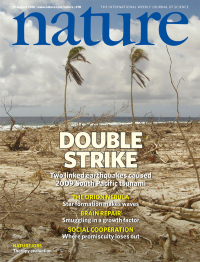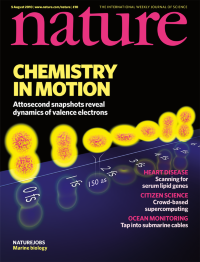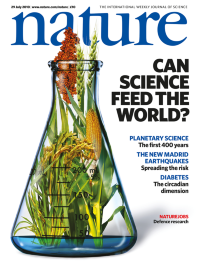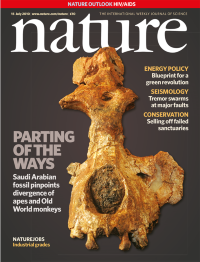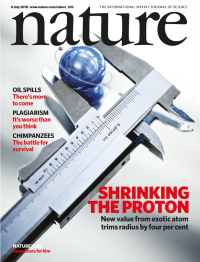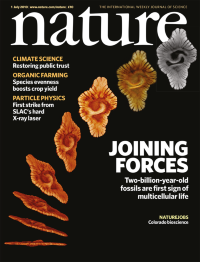Volume 466
-
No. 7308 12 August 2010
Until now, the earliest evidence for tool use by our ancestors or their relatives was from two sites in Ethiopia’s Awash Valley: stone tools manufactured about 2.5 million years ago and cut-marked bones of about the same age. Now, at Dikika in the Lower Awash Valley, the discovery of two bones from ungulates with cut and percussion marks — consistent with the use of stone tools to remove flesh and extract bone marrow — suggests an even earlier date of 3.4 million years ago for tool use by hominins . The marks are probably the work of Australopithecus afarensis, the species to which the iconic Lucy (from Hadar, Ethiopia) and the juvenile Selam (from Dikika) belong. Picture credit: Curtis Marean.
-
No. 7307 5 August 2010
Chemical reactions are triggered by the dynamics of valence electrons in molecular orbitals. A proof-of-principle demonstration reported in this issue shows how attosecond spectroscopy can be adapted to follow the hyperfast (subfemtosecond) motion of electron wavepackets in the valence shell - the bond-forming electrons - of krypton ions. Attosecond transient absorption spectroscopy of this type has the potential to reveal the elementary electron motions in molecules and solid-state materials that determine physical, chemical and biological properties. The cover depicts a sequence of snapshots of the oscillatory motion of a valence electron inside an atomic ion, reconstructed from attosecond pump-probe measurements. Credit: Christian Hackenberger, Ludwig Maximilians University of Munich.
-
No. 7306 29 July 2010
The UNs Food and Agriculture Organization estimates that world food production needs to increase by 70% by 2050. Under the title Can science feed the world?, a series of pieces in this issue looks at the contributions that plant scientists and biotechnologists can make towards attaining that goal. Credit: Jon Berkeley/Photos: Larry Fleming, Bill Barksdale, AgStock, Johner Bildbyra, Corbis.
-
No. 7305 22 July 2010
A population of the hibernating mammal Marmota flaviventris — the yellow-bellied marmot — has provided a unique data set that illustrates the effect of climate change on the annual events of animal life. Data from the past 33 years of a long-term study show that the animals, living in a subalpine habitat in the Upper East River Valley, Colorado, now emerge earlier from hibernation than they used to. This gives them a longer growing season so that they are now heavier when they start to hibernate again. At the same time, the fitness of large individuals has increased, leading to a rapid increase in population size. On the cover, a yellow-bellied marmot photographed in the Rocky Mountains. Photo credit: Mary Plage/Photolibrary.
-
No. 7304 15 July 2010
This fossil cranium of a new stem catarrhine from western Saudi Arabia allows palaeontologists to place a more accurate date than previously possible on the divergence of cercopithecoids (Old World monkeys) and hominoids (apes and humans) within Old World higher primates (Catarrhini). The new specimen dates to the mid-Oligocene, around 29 million to 28 million years ago, and has no crown catarrhine specializations other than the presence of a tubular ectotympanic, suggesting that the divergence of Old World monkeys and hominoids happened after that date. The cover shows the anterior view of the cranium, which has its lateral incisors, canines and broad molars in situ. The size of the cranium indicates a medium-sized primate, between 15 and 20 kilograms in body mass. Photo credit: Daniel Erickson/Bonnie Miljour, University of Michigan.
Nature Outlook
-
No. 7303 8 July 2010
A collaborative project for the accurate measurement of the radius of the proton, a basic subatomic component of all ordinary matter, has arrived at a surprising result. The new value for the protons root-mean-square charge radius — determined spectroscopically in muonic hydrogen in which the electron is replaced by the heavier muon &8211; is about 4% smaller than the previous best value. [Credit: Markus Fischer, Paul Piwnicki, Aldo Antognini/Paul Scherrer Inst.]
-
No. 7302 1 July 2010
A series of well preserved centimetre-scale fossils in an extended fossiliferous level within black shales near Franceville, in Gabon, West Africa, may represent the earliest evidence so far reported for cell-to-cell signalling and coordinated growth behaviour on the scale of macroorganisms. Dated at about 2.1 billion years old, a billion and a half years before the rapid expansion in multicellular life forms known as the Cambrian explosion, their shape and regular fabric indicate a multicellular degree of organization. On the cover, the structure of a macrofossil specimen revealed by microtomography-based imaging.


